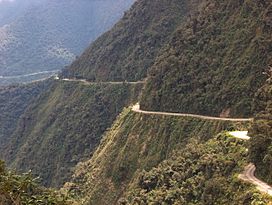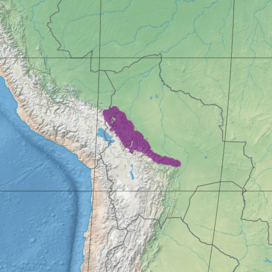Bolivian Yungas facts for kids
Quick facts for kids Bolivian Yungas |
|
|---|---|

Yungas Road through the Bolivian Yungas
|
|

Ecoregion territory (in purple)
|
|
| Ecology | |
| Realm | Neotropical |
| Biome | Tropical and subtropical moist broadleaf forest |
| Borders |
List
|
| Geography | |
| Area | 90,500 km2 (34,900 sq mi) |
| Countries | Bolivia and Bolivia |
| Conservation | |
| Protected | 49.37% |
The Bolivian Yungas is a special natural area in central Bolivia. It's a type of tropical and subtropical moist broadleaf forest, which means it's a warm, wet forest with lots of trees. This unique region is part of a larger area known as the Yungas.
Contents
Where is the Bolivian Yungas?
This amazing forest is found on the eastern side of the Andes mountains in Bolivia. It stretches from about 400 meters (1,300 feet) up to 3,500 meters (11,500 feet) high! A small part of it also reaches into southeastern Peru.
The Bolivian Yungas acts like a bridge between different types of environments. To the northeast, it connects with the Southwest Amazon moist forests. To the southwest, it meets the colder, higher lands of the Central Andean puna and wet puna.
What is the Climate Like?
The weather in the Bolivian Yungas can be like a tropical rainforest or a tropical monsoon. This means it's very warm and gets a lot of rain.
Fog and rain are common here, brought by winds from the north. This makes the Yungas very humid and wet, which is perfect for its lush forests.
Plants of the Yungas
The Bolivian Yungas is home to many interesting plants. You'll find lots of Epiphytes, which are plants that grow on other plants, like trees, but don't harm them. These include beautiful bromeliads, colorful orchids, and tall tree-ferns (Cyathea).
A special plant that helps identify this ecoregion is Chusquea bamboo. It's a common sight in these forests.
Animals of the Yungas
The Bolivian Yungas is full of amazing wildlife!
Mammals
Some of the mammals you might find here include:
- The spectacled bear (Tremarctos ornatus), which is the only bear native to South America.
- Geoffroy's cat (Leopardus geoffroyi), a small wild cat.
- The lowland tapir (Tapirus terrestris), a large animal with a short trunk.
- The powerful jaguar (Panthera onca).
- The jaguarundi (Herpailurus yagouaroundi), another type of wild cat.
- The pacarana (Dinomys branickii), a large rodent.
- The tiny dwarf brocket deer (Mazama chunyi).
Birds
This ecoregion is also a paradise for birds. Some interesting species include:
- The diademed tapaculo (Scytalopus schulenbergi).
- The green-capped tanager (Stilpnia meyerdeschauenseei).
- The colorful Andean cock-of-the-rock (Rupicola peruvianus), known for its bright orange feathers.
- The rare southern helmeted curassow (Pauxi unicornis).
People and the Yungas
The Bolivian Yungas is an important place for the Afro-Bolivian community. This is where many people of African descent in Bolivia live and have built their culture.
The Yungas Road, sometimes called the "Death Road" because it's so dangerous, connects the city of La Paz to the Bolivian Yungas. It's a famous road known for its steep drops and narrow paths.
Protected Areas
A lot of the Bolivian Yungas remains in its natural state. This is partly because the land is very steep, it rains a lot, and it's hard to get to.
Almost half of this ecoregion, about 49.37%, is protected. This means these areas are set aside to keep the plants and animals safe. Some of these protected areas include:
- Amboró National Park
- Bahuaja-Sonene National Park
- Carrasco National Park
- Cotapata National Park and Integrated Management Natural Area
- Espejillos Natural Monument
- Incacasani Altamachi National Park
- Isiboro Sécure National Park and Indigenous Territory
- Madidi National Park
- Pilón Lajas Biosphere Reserve and Communal Lands
- Tunari National Park
See also
In Spanish: Los Yungas (Bolivia) para niños

